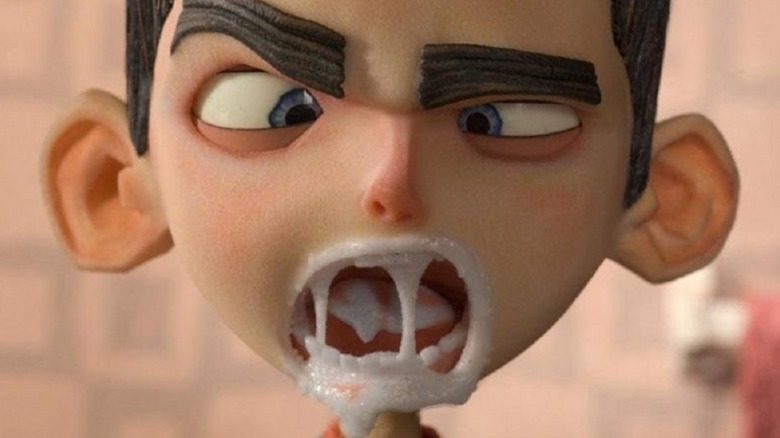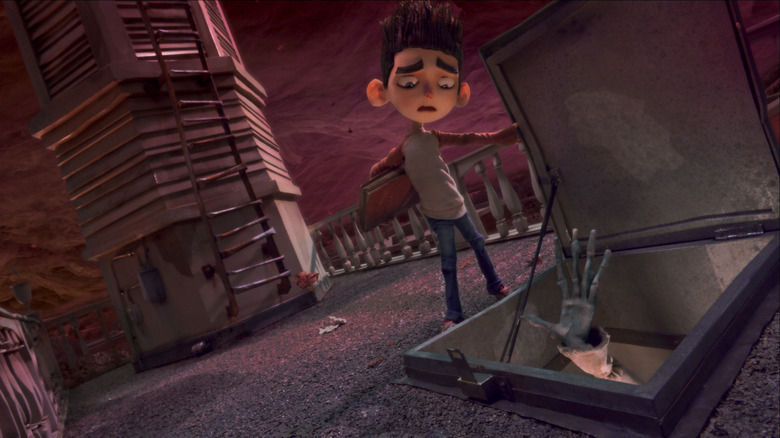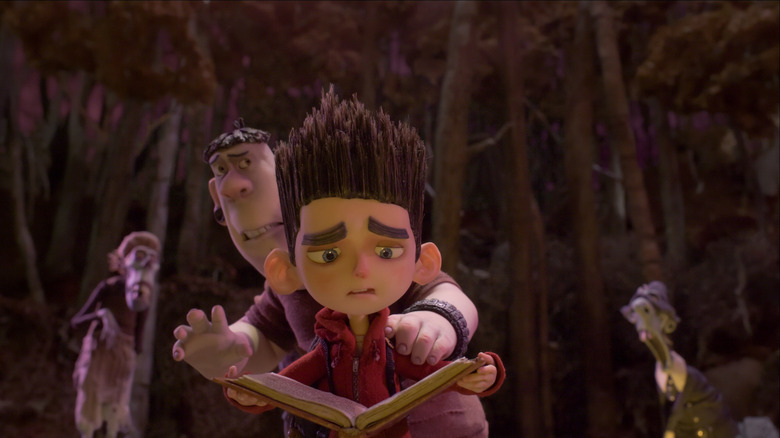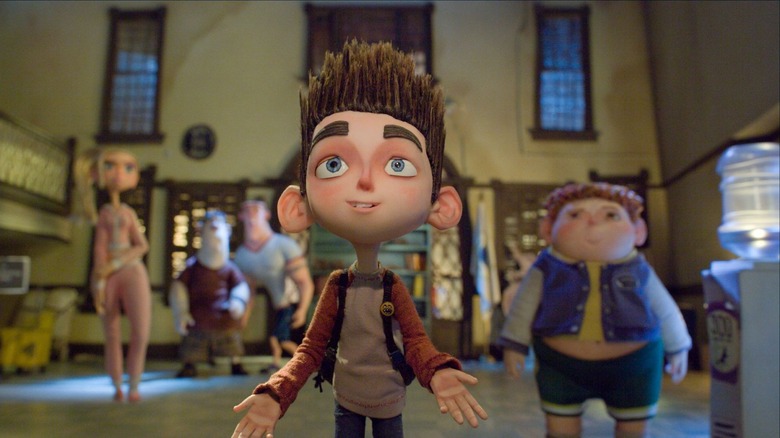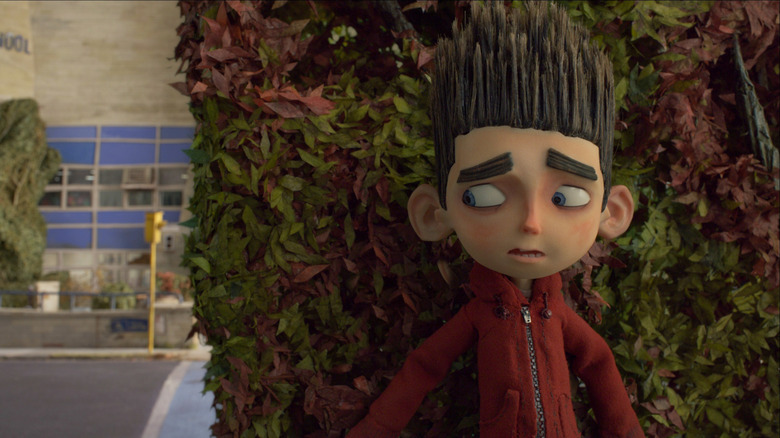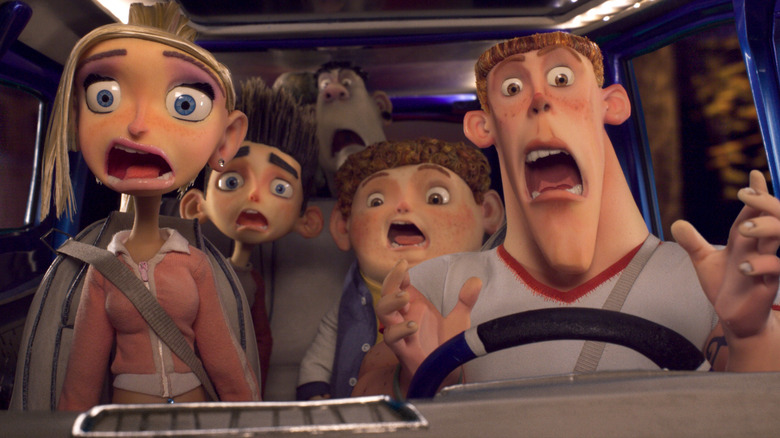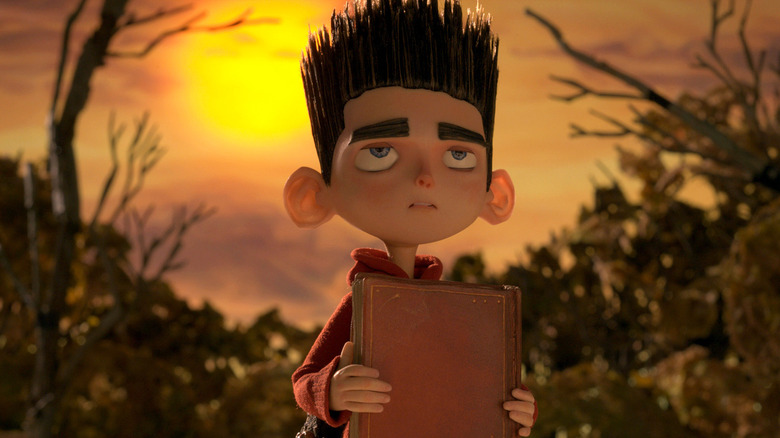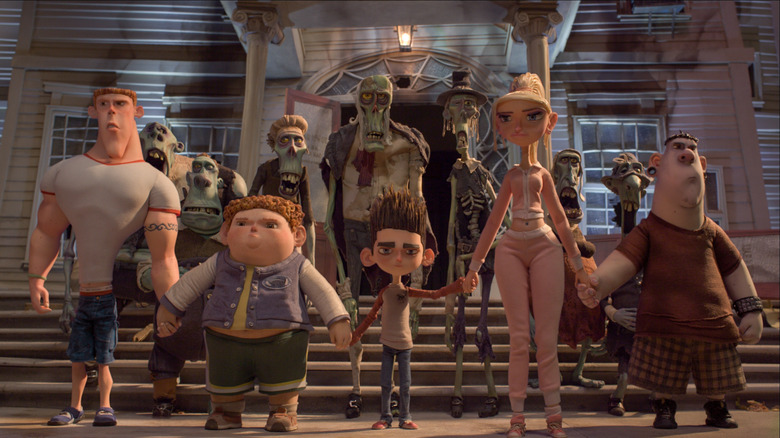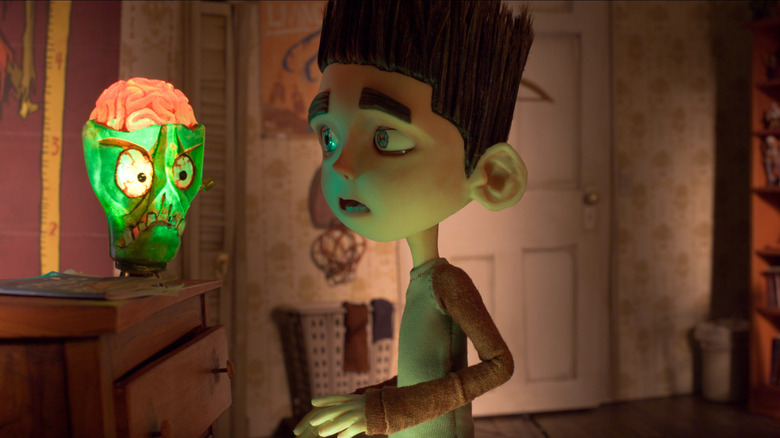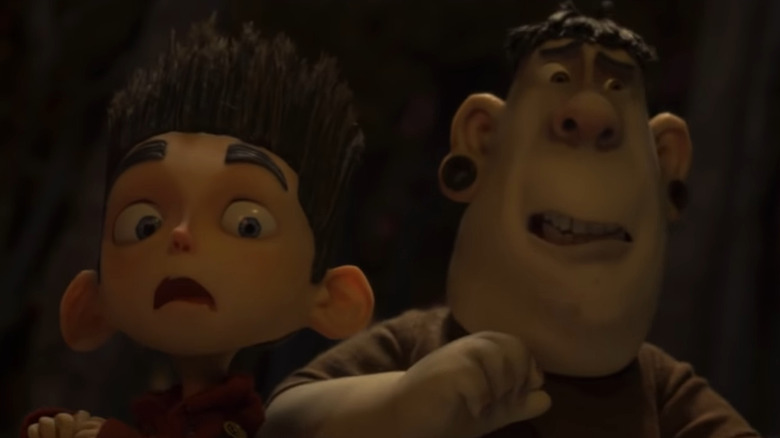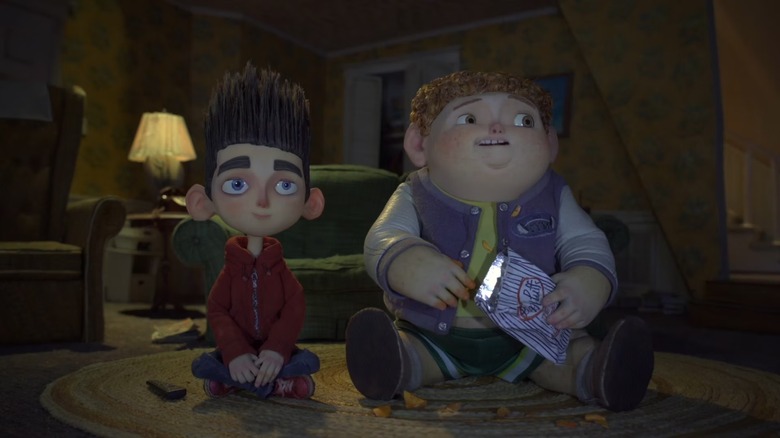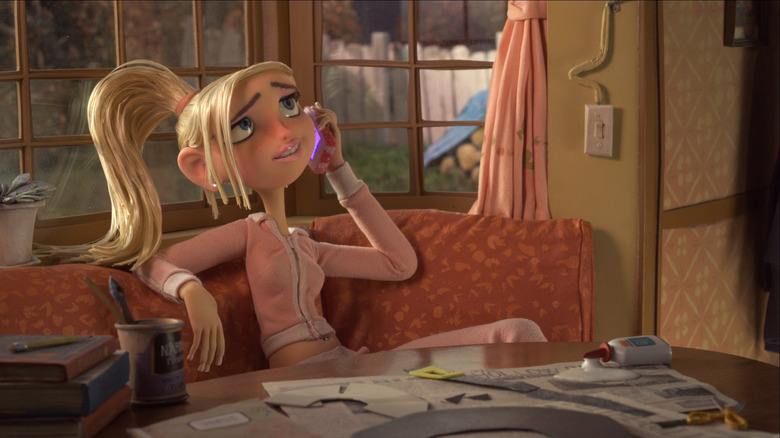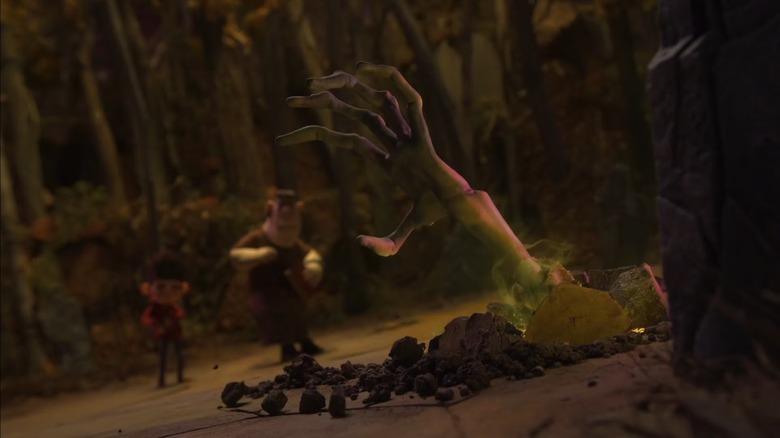The Untold Truth Of ParaNorman
The second feature film from the animation studio Laika, "ParaNorman" is a zombie movie for kids. Sure, that might sound unusual, but this homage to 1980s horror is a paean to outsiders that's perfect for youngsters. The titular lead, Norman (Kodi Smit-McPhee), is a kid who can see dead people and is ostracized from his family and neighbors as a result. His saga, which eventually entails having to contend with an army of the undead, provides a vibrant beating heart to "ParaNorman" that greatly informed its critical acclaim. As unique on a narrative level as it is with its dazzling stop-motion imagery, "ParaNorman" has become a cult classic for a reason.
But even with its sizeable fanbase, there are lots of facets about "ParaNorman" that are far from common knowledge. Everything from the earliest origins of the film to the importance of 3D printing in making the movie to even how the voice actors recorded their parts don't just comprise the untold truth of "ParaNorman." They also reflect the unique creative spirit that fueled this modern horror-comedy classic and gave an undead story substantial amounts of life.
The origin of ParaNorman
Given how long it normally takes to make an animated movie, it should be no surprise that the genesis for "ParaNorman" came long before the film ever hit theaters. However, even given the lengthy production time of animated movies, it's still shocking that "ParaNorman" was first conceived about 16 years before audiences would ever see it. Talking to Den of Geek, director Chris Butler recalled how it was around 1996 that he had the inspiration for a stop-motion zombie movie that youngsters could watch. This was the start of "ParaNorman," but the idea would quickly blossom from there.
After realizing how well zombies function as vessels for allegories, Butler then decided that a movie about the undead would be the perfect way to tell a story about the perils of being 11 years old. With this unique idea nestled in his brain, Butler then decided that taking cues from 1980s cinema would help the story prosper. Specifically, Butler was keen on taking notes from two legends of this era of filmmaking; John Hughes and John Carpenter. While the idea of merging something like "The Breakfast Club" and "They Live" seems weird at first, such an oddball pairing fit perfectly for Butler's vision of a movie about teenagers that get interrupted by a zombie flick. "ParaNorman" was an idea decades in the making, and all those years of creative gestation helped it get more and more detailed.
Why Laika chose ParaNorman to be its second movie
With the 2009 hit "Coraline," animation studio Laika had solidified itself as a notable newcomer in the field of big-screen animation. However, one film does not automatically turn a company into Pixar. It would take multiple hits for Laika to leave its mark on the world of feature films. This made the decisions surrounding what would be Laika's second motion picture extra critical. A bad concept for a sophomore effort could've jeopardized Laika's entire existence.
Talking to Animation World Network, Laika head Travis Knight noted that what helped make "ParaNorman" feel like the perfect second feature for Laika was its combination of a nifty take on zombie movies with a deeply personal intimate story. Knight also noted that he related to protagonist Norman, specifically how this kid felt like an outsider growing up. Knight said that so many people at Laika felt this way as kids that the movie was "basically autobiographical." Seeing these personal connections, not to mention the chance to explore new visual concepts that were never touched in "Coraline," made "ParaNorman" a no-brainer choice to be Laika's second feature film.
Why did co-director Sam Fell join the project?
"ParaNorman" is the brainchild of Chris Butler, but that doesn't mean he's the only credited director on this expansive project. Sam Fell is also a director on "ParaNorman," with the filmmaker coming onto the film well into its production. Though it wasn't something he originated, Fell still harbored a passion for the movie, mainly because of how ambitious it was. Reading the script, he was astonished at the idea of pulling off this entire movie in the medium of stop-motion animation.
Considering that, Fell came aboard the project as his third feature-length directorial effort following "Flushed Away" and "The Tale of Despereaux." Joining "ParaNorman" when it was already off to the races, Fell was constantly worried the project would be canned at any moment. As he explained to ComingSoon.net, "I was expecting at some point we would be reined in, and at some point, I thought we would be pulled back either by practical reality or for financial reasons or maybe even the studio would get cold feet and go, 'Oh my God, this story may be a little too dramatic.'"
Instead, Fell was pleased with how everybody involved rose to the challenge and lived up to his expectations for what such an ambitious feature could be. Though he wasn't the one who originated "ParaNorman," Sam Fell was still proud to be involved with such an audacious take on an animated family movie.
How the directors made darker material work
When it comes to kid's entertainment, there can be a cautious attitude that deters artists from engaging with truly dark material. This is despite children throughout the ages being told horrific stories by the Brothers Grimm or other disturbing fairy tales, not to mention classic pieces of cinema like "Snow White and the Seven Dwarfs" featuring sequences that petrified adolescent viewers. The history of entertainment aimed at youngsters has often involved material that's meant to frighten. "ParaNorman" is certainly a part of that history given that it's aimed at kids but features a story about the undead and witch trials.
Talking to Den of Geek, director Chris Butler noted that directors, like himself, who want to tackle weighty or dark material in kid's movies "have to do it responsibly." In the case of "ParaNorman," this entailed cracking the proper tone, one that could allow the feature to function as a rollicking adventure but also as something with weightier issues on its mind. Part of how Butler made sure the film would be digestible for children was by making sure there were as many gags and frivolous moments as there were scary segments of the production. It's not easy to find that balance, but in doing so, "ParaNorman" continued the long tradition of quality kid's fare that isn't afraid to be either scary or entertaining.
The historic use of 3D printers in ParaNorman
The process of 3D printing has made the world of stop-motion animation unspeakably easier. Materials needed for characters in these projects — namely elements related to facial expressions like eyes and mouths — that would need to be arduously adjusted by hand are now done with the wonders of 3D printing. An assortment of mouth and eye shapes can be created for whatever situation a screenplay calls for. Though used on Laika's debut feature, "Coraline," the magic of 3D printing was especially useful in the production of the studio's second production, "ParaNorman."
In an in-depth breakdown of Laika's use of 3D printing by Engadget, it was noted that the company initially invested $110,000 in a PolyJet plastic printer, which shows how much these filmmakers believed 3D printing could be a boon to claymation. And thanks to 3D printing, the titular lead of "ParaNorman" was capable of making 1.5 million different expressions, as opposed to Jack Skellington of "The Nightmare Before Christmas," who was only capable of delivering around 800 expressions two decades earlier.
While some animation studios run away from the possibilities of new technologies, the financial investments and creative accomplishments of Laika involving 3D printing make it clear the studio has embraced modern breakthroughs to improve its animation capabilities.
Why Jon Brion was selected as ParaNorman's composer
Jon Brion is no stranger to film scores, but most of his work as a composer in this area has been with decidedly adult-skewing features. "Magnolia," "Eternal Sunshine of the Spotlight Mind," and "Synecdoche, New York" are just a few examples of the iconic but highly unorthodox movies that Brion has delivered music for. This makes his presence on a kid-friendly movie like "ParaNorman" seem initially inexplicable, though there was a method to the madness of bringing him aboard this project.
Speaking to ComingSoon.net, directors Sam Fell and Chris Butler revealed that partially why Brion was asked to compose an original score for "ParaNorman" was that his work had been used as temp music during production of the film. Specifically, Butler remembers using tracks from "Eternal Sunshine of the Spotless Mind" when putting a rough version of the opening scenes of "ParaNorman" together.
Having become so accustomed to hearing his tunes connected to the world of "ParaNorman," the filmmakers asked Brion to join the project as its composer. Fell noted that this brought new challenges to Brion, as he'd never worked on a movie with lengthy chase scenes or spectacle-driven sequences before. But Brion managed to face those challenges and create a distinctive score that could stand alongside his classic works.
The importance of Mitch's sexuality
At the very end of "ParaNorman," the film reinforces its theme of people not being exactly as they seem by revealing a key detail about supporting character Mitch (Casey Affleck), who's introduced as a himbo who fits the stereotypical heterosexual jock mold. Norman's sister, Courtney (Anna Kendrick), lusts after Mitch the entire movie, but her crush will never be requited. Mitch reveals in his final lines that he has a boyfriend who's "a total movie junkie." The presence of an openly gay character in "ParaNorman" is a notable and welcome detail that lends extra depth to the movie's central theme of humanizing societal outsiders and asking viewers to not judge a book by its cover.
Speaking in an interview with GLAAD, which mentioned that Mitch made history as the first openly gay character to appear in a major PG-rated animated film, director Chris Butler said that the inclusion of a gay character like Mitch was inevitable because "ParaNorman" "is a story about tolerance." He went on to say, "If we were going to champion the idea of accepting people for who they are, then we should really have the strength of our convictions, and that meant breaking a few taboos. Mitch being gay was one of them."
Butler noted that he'd heard anecdotes about how the response to Mitch being queer had inspired varying responses from movie theater audiences, with some excitedly cheering at the reveal and others being appalled by it. But no matter how it went over, this historic reveal played perfectly into the central theme of "ParaNorman."
How Kodi Smit-McPhee's perception of ParaNorman changed as he aged
The lengthy amount of time it takes for an animated movie to come together means the cast members of these films can perceive the project one way when they start and a totally different way once it's all finished. For example, take Kodi Smit-McPhee, who was brought on to provide the voice of Norman in "ParaNorman." As it turns out, his perception of the film changed over the numerous years he was attached to the film.
Talking to ScreenRant, Smit-McPhee noted that when he started recording his lines for "ParaNorman," he was 14 years old. At that age, he was only conceiving of "ParaNorman" as an adventure romp. But as the years went on, he got older and was able to process the deeper themes in the film related to bullying and prejudice. Gradually, he became cognizant that he was working on something a bit more profound than he initially anticipated. It's doubtful McPhee could've had that kind of epiphany if "ParaNorman," like so many animated movies, hadn't taken years to create.
The voice actors recorded together
Typically, major animated movies have their actors record their lines separately. It's a model meant to allow flexibility on the part of big-name performers, who can record their lines wherever and whenever their busy schedules allow. However, certain animated projects do try and get their actors to record together, as to find the spontaneous chemistry and line deliveries that you can only get when bouncing off other people. "ParaNorman" belonged to the latter group of animated titles, with its lead actor, in particular, getting to record alongside several members of the star-studded cast.
Talking to ScreenRant, "ParaNorman" lead Kodi Smit-McPhee recalled how he revealed that he was able to do some of his recording sessions with co-stars Tucker Albrizzi, Anna Kendrick, and Christopher Mintz-Plasse. While remarking on how uncommon it was for big animated films to have their actors work together in this manner, he said that it was a boon for his performance. In particular, he felt there was a much more natural delivery to his lines whenever he was able to develop a rapport with another actor who was in the room. Just as the titular lead of "ParaNorman" was a rebel who ended up saving the day, so too did "ParaNorman" the movie go against the grain, specifically on how animated movies traditionally record their dialogue.
The box office run of ParaNorman
Though movies told entirely in stop-motion animation have often garnered critical acclaim, they've had a much spottier track record at the box office. In North America, only one stop-motion animated title, "Chicken Run," has ever cleared $100 million. In other words, the barometers for financial success for stop-motion titles are much different than the ones for computer-animated titles. It also means that, even without shattering records, "ParaNorman" became one of the bigger stop-motion titles ever domestically.
In its domestic run, "ParaNorman" grossed $56 million, which makes it the fourth highest-grossing stop-motion film (not adjusting for inflation). That was notably below the $75.2 million North American haul of "Coraline," but it narrowly edged out the $53.3 million gross of the much more star-studded "Corpse Bride." Internationally, "ParaNorman" took in another $52 million for a $108 million worldwide haul. Admittedly, this wasn't quite enough to bring "ParaNorman" to profitability given its $60 million budget. Still, at least in North America, "ParaNorman" did better than average business for a stop-motion animated film, even if it also reinforced that there's a ceiling for how big most of these kinds of movies can be at the box office.
Why ParaNorman was perfect for stop-motion animation
There aren't a lot of stop-motion movies released in the U.S., so when a new one comes along, it makes us wonder, "Why is this particular story being told in this medium?" After all, stop-motion features take an exorbitant amount of time to create, not to mention their limited potential at the box office. If someone is going to undertake all the effort it requires to pull off a movie like "ParaNorman," they should definitely know why they want to engage in the world of stop-motion in the first place.
But for Laika head Travis Knight, there was no question that stop-motion was the perfect mode to tell the story of "ParaNorman." Speaking to Animation World Network, Knight noted, "The fact is that stop-motion is physical work. You see the hands and the attention of the artist behind every emotion. That gives it its humanity. That's just something that computer animation, for all its wonders, can't emulate."
In other words, Knight felt that such an idiosyncratic artform was perfect for a film like "ParaNorman," which is all about following the beat of your drum and refusing to give in to conformity. While the imperfect qualities of stop-motion animation may turn off other artists or studio executives, Knight saw them as the perfect reasons it should be used on "ParaNorman."
Why the head of Laika worried about ParaNorman
"ParaNorman" is a bit off the beaten path for a mainstream American animated movie and not just because it's told in the medium of stop-motion animation. It's also a feature that engages in horror film imagery, is devoid of talking animals, and isn't afraid to tackle challenging material related to who or what gets defined as a monster in society. It's easy to imagine traditional studio executives panicking over this movie and its content. Even Laika head Travis Knight admitted to Animation World Network that there were several spots in "ParaNorman's" production that he was nervous about this project and its ambitions.
However, Knight noted that these were the same feelings he had when Laika embarked on making the hit film "Coraline," so it wasn't like there was zero precedent for such emotions at the studio. To boot, Knight noted that his nerves were never about a lack of confidence in "ParaNorman" but rather in how audiences would respond to the unique creative vision of the feature. "The data does not exist," Knight bluntly stated, regarding any metrics suggesting people would line up in droves to see a film as unorthodox as "ParaNorman."
However, he also noted that he always wants to worry about the movies Laika makes because that indicates they're trying bold and new things. For Knight and the artists at Laika, getting nervous over "ParaNorman" was an indication they were on the right track creatively, not a sign to quit something unusual.
